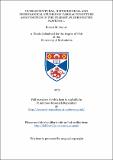Files in this item
Ultrastructural, histochemical and physiological studies on cardiac structure and function in the teleost, Pleuronectes platessa L.
Item metadata
| dc.contributor.advisor | Cobb, James L. S. | |
| dc.contributor.author | Santer, Robert M. | |
| dc.coverage.spatial | vi, 151 p. | en_US |
| dc.date.accessioned | 2018-07-05T13:31:42Z | |
| dc.date.available | 2018-07-05T13:31:42Z | |
| dc.date.issued | 1973 | |
| dc.identifier.uri | https://hdl.handle.net/10023/14998 | |
| dc.description.abstract | A general study has been made on cardiac function in the plaice (Pleuronectes platessa) involving ultrastructural histochemical and physiological studies on the adult and developing fish. Myocardial cells have an average diameter of 3.2u. They lack a T-system and nexus contacts and have a very sparse sarcoplasmic reticulum. The sino-atrial region is heavily innervated but no pace maker cells have been identified. Cells resembling Purkinje cells of higher vertebrate myocardia are seen in the plaice myocardium but they do not run in tracts. There is no coronary blood supply which is a consequence of the absence of an outer cortical layer of myocardium. The development of the heart resembles that process as seen in the chick, but there are minor sequential differences. By Day 24 the "early larval" heart has formed which is a tri-laminar structure - a myocardial layer bounded externally by epicardium and internally by endocardium. This condition lasts until the 4a (Ryland) stage with the onset of endocardial invagination. This is the criterion distinguishing the "late larval" heart which persists until two months post-metamorphosis. Thus cardiogenesis is independent of hatching and metamorphosis. The heart is innervated only parasympathetically through the cardiac branch of the vagus. The cardiac ganglion situated at the sino-atrial region. The strium is sparsely innervated and the ventricle is aneural. The absence of a sympathetic innveration is concluded from the following a) No specific catecholamine fluorescence is seen with the Falck technique. b) 6-hydroxydopemine does not degenerate any axons. C) Intraaxonal granular vesicles are not depleted by reserpinc and AChE was localized around axons containing such vesicles. D) No adrenergic-type axons were seen by electron microscopy. Differential vagal stimulation of 3Hz and 7Hz causes excitation and inhibition respectively, both effects being blocked by 10-6 g/ml atropine and are thus cholinergically mediated. On cessation of prolonged inhibitory stimulation there is marked increase in heartrate, and in quiescent hearts one or two beats are initiated after stimulation. Vagal stimulation causes a hyperpolarization in atrial cells. It is proposed that all the excitatory effects of vagal stimulation are due to rebound excitation from an inhibitory hyperpolarization. At high frequencies the hyperpolarisations summate to give total inhibition. At lower frequencies of stimulation the heartbeat is increased to rates dependent upon the time course of the hyperpolarization and the refractory period of the heart. The rebound excitation persists in the presence of atropine and bretylium (both at 10-6 g/ml) and is therefore probably a response of the muscle cell membrane and is nerve-mediated. | en_US |
| dc.language.iso | en | en_US |
| dc.publisher | University of St Andrews | |
| dc.subject.lcc | QL638.P7S2 | en |
| dc.subject.lcsh | Pleuronematidae | en |
| dc.title | Ultrastructural, histochemical and physiological studies on cardiac structure and function in the teleost, Pleuronectes platessa L. | en_US |
| dc.type | Thesis | en_US |
| dc.contributor.sponsor | Science Research Council (Great Britain) | en_US |
| dc.type.qualificationlevel | Doctoral | en_US |
| dc.type.qualificationname | PhD Doctor of Philosophy | en_US |
| dc.publisher.institution | The University of St Andrews | en_US |
This item appears in the following Collection(s)
Items in the St Andrews Research Repository are protected by copyright, with all rights reserved, unless otherwise indicated.

